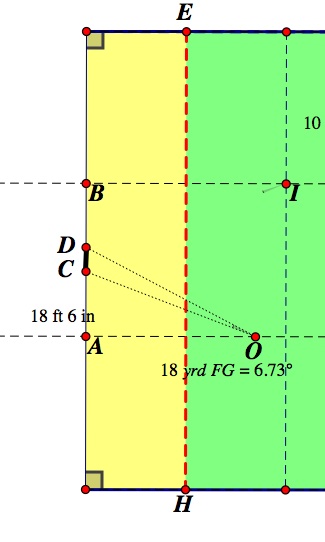

Write Up 6: "A Coach's Dilemma"
The Dilemma:

Background Information:
The "field goal" is one of the most important parts of American Football and has evolved over the years. In today's football game, a team that has a good field goal kicker has a tremendous advantage throughout the season. Mainly for the reason that majority of the close games come down to a last second field goal. These are the time when the position of a field goal kicker becomes the most important job on the field and also becomes the job with the most pressure. Before we dive into the mid of a coach and his kicker, let's give some background on the dynamics of the American football field. First, the end zone is measured 10 yards in depth which is added on to the length of a kick since the field goal post is located in the back of the end zone. Also when a FG is being attempted, the kicker does not kick directly from the line of scrimmage. Traditionally, the holder, who holds the football in place for the kicker, sits 7 yards behind the line of scrimmage adding another 7 yards to the length of the kick. Let's give an example, suppose the line of scrimmage is at the 30 yard line and the offense is going to attempt a field goal. Therefore, the end zone adds another 10 yards to the kick and the holder will be 7 yards behind the line of scrimmage. Therefore, a FG attempt from the 30 yard line will actually be a 47 yards FG attempt since (30yd line)+(10 yd. end zone)+(7yrd behind line)= 47 yard attempt. Hence, all of these characteristics should be taking into account when discussing a FG attempt in out exploration.
The College Football Field:

The results from I found from GSP were opposite of what I hypothesized. From my exploration, we can see that the closer to the FG post that the kicker resides, the better angle the kicker has for his FG attempt. Let's start discussing a FG attempt from the 40 yard line. First, from the 40 yard, line the FG attempt is actually a length of 57 yards which is rarely tried by any kicker in the NCAA. Most likely in this case, a coach would elect to punt the football instead of attempting a field goal. For this exploration's purposes, let say a coach elects to attempt a FG from the 40 yard line. Therefore, the line of scrimmage is at the 33 yard line and the ball is placed at the left hashmark. The angle that the kicker faces is a very small measure of 2.69 degrees. This means that the kicker not only has to boom a kick 50 yards, he also must kick the ball will very little error to overcome the kicking angle of 2.69 degrees. Now let's say on the next offensive drive, the FG attempt is from the 30 yard line. Therefore, the kicker will be attempting a 40 yard kick from a hashmark. For this attempt, the kicker faces a little better angle than the 50 yard try, but not by much. The angle for a 40 yard attempt is 3.32 degrees. This gives the kicker about a 1 degree increase in kick angle when kicking from the 30 yard line instead of the 40 yard line. The trend continues as the kick becomes shorter. The kick angle on a 30 yard try will be 4.31 degrees which is now a 2 degree increase in kick angle compared to a 50 yard attempt. In addition, a FG attempt from the 10 yard line which is a 20 yard try, will have a kick angle of 6.02 degrees. There is a 4 degree difference in kicking from the 10 yard line and kicking from the 40 yard line; making the kick from the 10 yard line much easier than from the 40 yard line. Since this trends continues, the best angle for a kicker kicking from the hashmark will be from the 8 yard line. This attempt will be an 18 yard FG attempt since the end zone is 10 yards and the holder is 7 yards behind the line of scrimmage. The image below show the 18 yard attempt and the kick angle faced by the kicker. If a FG try is attempted from the 8 yard line, then the kick angle will be roughly 7 degrees, which is the best possible angle available if a kicker is kicking from a hashmark.

In conclusion, the result found in tis exploration shows the importance of field position in an FG attempt. The closer the line of scrimmage is to the FG post, the better the angle will be for the kicker when he attempts the FG. The results of this exploration also shows the consequences of penalties before attempting a FG. Let's say that a kicker is going to attempt a 40 yard FG but before the ball if snapped, the team receives a five yard penalty for delay of game. This will result in the ball being moved from the 30 yard line to the 35 yard line. Now the FG attempt is a 45 yard try instead of a 40 yard try. The kick angle for a 40 yard attempt from the hashmark is 3.32 degrees. If five yard penalty is enforced and the attempt becomes a 45 yard try, the kick angle decreases to 2.5 which is close to a one degree difference. Since the kick angle is already very small, a penalty is a devastating consequence which can result in a harder kick and ultimately a missed FG. Therefore, if a coach takes a five yard penalty to make the kick, then he has made a big mistake and actually make the kick much harder because the kick angle will become more difficult.